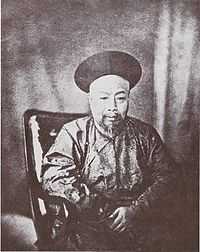Ye Mingchen
| Ye Mingchen | |
|---|---|
 | |
| Governor of Liangguang | |
| In office 1852–1858 | |
| Preceded by | Xu Guangjin |
| Succeeded by | Huang Zonghan |
| Personal details | |
| Born | 1807 Hanyang, Hubei |
| Died | April 9, 1859 (aged 52) Calcutta, India |
| Occupation | Politician |
Ye Mingchen (simplified Chinese: 叶名琛; traditional Chinese: 葉名琛; pinyin: Yè Míngchēn; Wade–Giles: Yeh Ming-ch'en) was a high-ranking Chinese official during the Qing Dynasty, known for his resistance to British influence in Guangzhou in the aftermath of the First Opium War and his role in the beginning of the Second Opium War.
Early career
Ye came from a scholarly family in Hubei province and was awarded the highest degree in the imperial exams in 1835, after which he briefly held the position as a compiler in the imperial elite school, the Hanlin Academy. In 1838, Ye received his first official appointment as prefect of Xing'an in Shaanxi province and he subsequently rose rapidly through the ranks in the Qing civil service. In the following years he served as circuit intendant of Yanping in Shanxi provinces, salt inspector in Jiangxi, surveillance commissioner in Yunnan and financial commissioner first in Hunan, later in Gansu and finally Guangdong province.
Conflicts with Britain
In 1848, Ye was appointed governor of Guangdong province, which brought him into open conflict with Britain because of his refusal to allow British traders to reside in the city of Guangzhou proper, which the British claimed they had a right to according to the Treaty of Nanking. As a matter of fact, the treaty read differently in its English and Chinese versions, the latter only permitting foreigners to reside temporarily in the harbors of the newly opened treaty ports.[1]

As a reward for his ostensible success in keeping the British out of Guangzhou, he was promoted to Viceroy of Liangguang as well as imperial commissioner in 1852, which made him the chief official in charge of relations with the West. Ye Mingchen remained steadfastly opposed to yielding to British demands, but he was not able to resist the British with military force. The conflict with the British Empire came to a head in 1856, when Ye seized the Chinese-owned lorcha Arrow, which was illegally flying the British flag at the time.[2] [3] This provided the British and French with an excuse to start the Second Opium War. During the hostilities, British forces captured Ye and brought him as a prisoner of war to Calcutta in British India where he died over fasting.
Legacy
The Cantonese community is said to have respected Ye Mingchen for his intransigence against the British, but also ridiculed his inability to resist them on the battlefield. In Guangzhou he was known as the "six nots": "he would not fight, not make peace and not defend; he would not die, not capitulate and not run away." Ye briefly won the favor of the Xianfeng Emperor, but his policy fell out of favor when hostilities broke out. Contemporary British public opinion regarded "Commissioner Yeh" as the embodiment of Chinese xenophobia and he was frequently caricatured in British media. But his image in the West was not unanimously negative. For instance, the German writer Theodor Fontane, who learned about Ye while working in London in the late 1850s, was touched by Ye's fate and later published an essay on the official.[4]
In official Chinese historiography, Ye was long given the blame for precipitating the Second Opium War, but now he is frequently hailed as an early Chinese patriot and a monument have been erected in his memory in Guangzhou.[5]
Iconography
A sketch of Ye captured and kept on board of HMS Inflexible was made to depict him as a hideous monster. It got broad circulation as British propaganda justifying the Arrow (second Opium) War.[6]
References
- ↑ John King Fairbank, Trade and Diplomacy *on the China Coast: The Opening of the Treaty Ports, 1842-1854 (Cambridge, MA: Harvard University Press, 1953) vol. 1, p. 201f.
- ↑ http://en.wikisource.org/wiki/China_and_the_Attack_on_Canton
- ↑ http://en.wikisource.org/wiki/China_and_the_Attack_on_Canton
- ↑ (in Chinese). For original reference, see Fontane, Theodor. "Yeh, Eine Studie (Nach Der "Times")." In Sämtliche Werke, edited by Edgar Gross. München: Nymphenburger Verlagshandlung, 1959. Vol, 18a, pp. 797-806.
- ↑ Article from Southern Metropolis Daily (in Chinese).
- ↑ J.Y. Wong, Deadly Dreams, p.8
Further reading
- Hummel, Arthur William, ed. Eminent Chinese of the Ch'ing Period (1644-1912). 2 vols. Washington: United States Government Printing Office, 1943.
- Huang, Yen-yü. "Viceroy Yeh Ming-ch'ên and the Canton Episode (1856-1861)." Harvard Journal of Asiatic Studies 6, no. 1 (1941): 37-127.
- Nolde, John J. "The 'False Edict' of 1849." Journal of Asian Studies 20, no. 3 (1961): 299-315.
- Wong, J. Y. Yeh Ming-Ch'en: Viceroy of Liang Kuang 1852-8. Cambridge, New York: Cambridge University Press, 1976.
| Government offices | ||
|---|---|---|
| Preceded by Xu Guangjin |
Viceroy of Liangguang 1852–1858 |
Succeeded by Huang Zonghan |